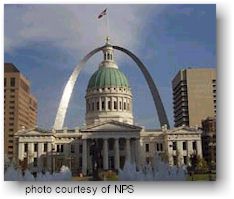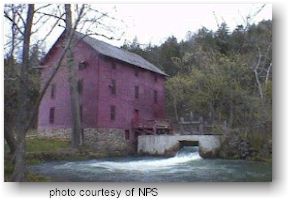


|

|
 Jefferson National Expansion Memorial |
 Alley Roller Mill at Ozark National Scenic Riverways |
|
California National Historic Trail - The California
Trail carried over 200,000 gold-seekers and farmers to the gold fields
and rich farmlands of California during the 1840's and 1850's, the greatest
mass migration in American history. Today, more than 1,000 miles of
trail ruts and traces can still be seen in the vast undeveloped lands
between Casper Wyoming and the West Coast, reminders of the sacrifices,
struggles, and triumphs of early American travelers and settlers.
George Washington Carver National Monument - George Washington Carver's boyhood home consists of rolling hills, woodlands, and prairies. The 210 acre park has a 3/4 mile nature trail, museum, and an interactive exhibit area for students. The cultural setting includes the 1881 Historic Moses Carver house and the Carver cemetery. Harry S. Truman National Historic Site - Harry S Truman National Historic Site includes the Truman Home in Independence, Missouri, and the Truman Farm Home in Grandview, Missouri. Jefferson National Expansion Memorial - Jefferson National Expansion Memorial consists of the Gateway Arch, the Museum of Westward Expansion, and St. Louis' Old Courthouse. During a nationwide competition in 1947-48, architect Eero Saarinen's inspired design for a 630 foot stainless steel arch was chosen as a perfect monument to the spirit of the western pioneers. Construction of the Arch began in 1963 and was completed on October 28, 1965, for a total cost of less than $15 million. Lewis and Clark National Historic Trail - This site celebrates the heroic expedition of the Corps of Discovery, led by Captain Meriwether Lewis and Captain William Clark. Thirty three people traveled with them into unknown territory, starting near what is now known as Wood River, Illinois in 1804, reaching the Pacific Ocean in 1805 and returning in 1806. Oregon National Historic Trail - As the harbinger of America's westward expansion, the Oregon Trail was the pathway to the Pacific for fur traders, gold seekers, missionaries and others. Beginning in 1841 and continuing for more than 20 years, an estimated 300,000 emigrants followed this route from Independence, Missouri to Oregon City, Oregon on a trip that took five months to complete. The 2,170 mile long trail passes through Missouri, Kansas, Nebraska, Wyoming, Idaho and Oregon. |
Ozark National Scenic
Riverways - Ozark National Scenic Riverways was created
by an Act of Congress on August 24, 1964, to protect 134 miles of the
Current and Jacks Fork Rivers in the Ozark Highlands of southeastern
Missouri. The clean, clear waters of these two beautiful rivers provide
excellent opportunities for johnboating, canoeing, swimming, fishing
and tubing. Hunting is also an authorized use within the Riverways'
boundaries. The landscape is predominantly rural, with broadleaf forests
and occasional open fields.
Pony Express National Historic Trail - The Pony Express National Historic Trail was used by young men on fast paced horses to carry the nation's mail across the country, from St. Joseph, Missouri to Sacramento, California, in the unprecedented time of only ten days. Organized by private entrepreneurs, the horse-and-rider relay system became the nation's most direct and practical means of east-west communications before the telegraph. Though only in operation for 18 months, between April 1860 and October 1861, the trail proved the feasibility of a central overland transportation route, and played a vital role in aligning California with the Union in the years just before the Civil War. Ulysses S. Grant National Historic Site - Established as a unit of the National Park Service in 1990, the park commemorates the life, military career, and Presidency of Ulysses S. Grant, as well as his wife Julia Dent Grant. The site, also known as White Haven, consists of 9.65 acres holding five historic structures (main house, stone building, barn, chicken house, and ice house). Wilson's Creek National Battlefield - The battle fought here on August 10, 1861, was the first major Civil War engagement west of the Mississippi River, involving about 5,400 Union troops and 12,000 Confederates. Although a Confederate victory, the Southerners failed to capitalize on their success. The battle led to greater federal military activity in Missouri, and set the stage for the Battle of Pea Ridge in March, 1862. Wilson's Creek was also where the first Union general, Nathaniel Lyon, met his death. With the exception of the vegetation, the 1,750 acre battlefield has changed little from its historic setting, enabling the visitor to experience the battlefield in near pristine condition. Trail Of Tears National Historic Trail - In 1838, the United States government forcibly removed more than 16,000 Cherokee Indian people from their homelands in Tennessee, Alabama, North Carolina, and Georgia, and sent them to Indian Territory (today known as Oklahoma). The Trail of Tears National Historic Trail commemorates the removal of the Cherokee and the paths that 17 Cherokee detachments followed westward. Today the trail encompasses about 2,200 miles of land and water routes, and traverses portions of nine states. |
|
|
|
For more information visit the National Park Service website |
|||